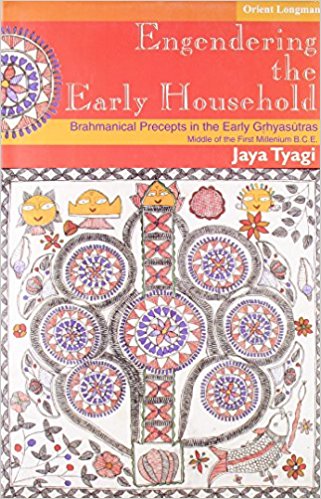In the brahmanical patriarchal scheme, the husband is the harbinger of brahmanical patriarchal ideology; an ally; one who puts into practice the patriarchal formulations of the texts in the actual laboratory of human experience—the grha. This sentence from Jaya Tyagi’s book (p. 154) provides a clear pointer to the focus of her monograph. Her study covers the period from the eighth century bc to the fifth century bc which is the time of the early Grhyasutras. She perceives this period as marking a social transition. According to the author, Sutra literature represents the crucial period of transition from the earlier phase when rituals were projected as the responsibility of the community and elite brahmanas, to a stage which began with the later Samhitas and Brahmanas, and culminated in the Grahyasutras, where the performance of rituals was shifted to the micro level of society, that of individual households (p. 12).
The emergence of the household is linked to the larger ideology of the new state systems which felt threatened by the potentially powerful kin units that could act as rival centres of power. Instead, the grha would both reflect royal authority and serve as its microcosm, replicating the patriarchal rationalization of power at the level of the household. More, important, the household would also generate resource for the state and serve the interests of the brahmins through the network of ‘dana’ and ‘dakshina’. In her understanding of the place of women within the household, Jaya draws upon the nature versus culture debate. State formation, technology and production represented material culture and the grha was seen as a model for state and society. Woman who was principally perceived as the means of reproduction, was associated with nature while man who was termed as the grhapati, was projected as the carrier of culture.
The purpose of ritual was to project the man as the head of the household. Control over the domestic space would set the tone in society for acceptance of and conformity to the control over the rajya by the king. Accordingly the householder is portrayed in the Grhyasutras as the performer of rituals in the grha. What was the role of women in the performance of these rituals? The author has painstakingly put together evidence and arguments to show that women were marginalized within the grhyasutra rituals. She argues that beginning with the Brahmana and continuing with the multiple grhyasutra texts, women’s role in rituals were sought to be diminished not only in common household rituals but even within these ritual performances associated specifically with women such as those associated with their reproductive functions such as the pumsavana ritual. This is directed by the male head to ask for male heirs. The author’s statement that this ritual was performed in the third month of conception comes as a surprise because according to Shastraic injunctions, no conception related ritual is to be performed before the fifth month and the pumsavana is usually performed in the sixth or the eighth month. I would suggest that the author should recheck the veracity of this statement because many of her subsequent arguments take off from this point.

